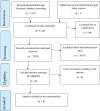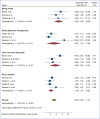The magnitude of second-trimester induced abortion and associated factors in Ethiopia: a systematic review and meta-analysis
- PMID: 40666252
- PMCID: PMC12259605
- DOI: 10.3389/fgwh.2025.1535329
The magnitude of second-trimester induced abortion and associated factors in Ethiopia: a systematic review and meta-analysis
Abstract
Background: Even though Ethiopia has a non-restrictive abortion law, abortion complications are one of the top five maternal morbidity and mortality causes in the country. Most women visit health facilities for pregnancy termination at second-trimester which leads to higher abortion-related complications than first-trimester abortion. There is no national evidence regarding the level of second-trimester-induced abortion in Ethiopia. This study aimed to determine the magnitude of second-trimester induced abortion and its determinant factors.
Methods: Online searches using different online bases such as PubMed, HINARI, SCOPUS, Google Scholar, and University digital libraries were conducted to identify candidate studies to be included in this systematic review and meta-analysis. The Newcastle-Ottawa Quality Assessment Scale (NOS) was used to assess the quality of studies to be included in this review. Data extraction and analysis were performed using Microsoft Excel and Stata 17 software respectively. The heterogeneity of studies was assessed using Cochran (Q test) and I2 test statistics. We assessed publication bias using a funnel plot and Egger's regression asymmetry test.
Results: Eight studies with a total study population of 3,659 were included in this review. The pooled prevalence of second-trimester induced abortion was 25.96% (95%, CI 14.42%, 37.49%) in Ethiopia. The finding of this systematic review indicated that being single [(OR = 5.20, 95%, CI 3.04, 8.90), I 2 = 0.00%, p = 0.69], delay in the diagnosis of pregnancy [(OR = 3.01, 95%, CI 1.23, 7.38), I 2 = 80.74%, p = 0.01], no formal/low education level [(OR = 3.54, 95%. CI 1.84, 6.78), I 2 = 69.71, 57.15%, p = 0.04], and being rural resident [(OR = 2.16, 95%, CI 1.61, 2.92), I 2 = 0.00%, p = 0.53] were factors significantly associated with second trimester induced abortion in Ethiopia.
Conclusion: The prevalence of second-trimester abortion was found to be high in Ethiopia. Being single, delay in the diagnosis of pregnancy, having no formal/low education level, and being rural residents were factors significantly associated with second-trimester induced abortion in Ethiopia. Enhancing the sexual and reproductive health literacy of reproductive-age women as well as access to safe abortion services are relevant measures to be taken to reduce late visits to health institutions for abortion services.
Keywords: Ethiopia; associated factors; induced abortion; review - systematic; second trimester.
© 2025 Mekie, Fenta, Ferede, Yehuala, Dagnaw, Ayele, Mengistu, Mengistie, Tadesse and Addisu.
Conflict of interest statement
The authors declare that the research was conducted in the absence of any commercial or financial relationships that could be construed as a potential conflict of interest.
Figures







Similar articles
-
Magnitude of postpartum hemorrhage and associated factors among women who gave birth in Ethiopia: a systematic review and meta-analysis.Reprod Health. 2022 Sep 21;19(1):194. doi: 10.1186/s12978-022-01498-4. Reprod Health. 2022. PMID: 36131345 Free PMC article.
-
Delays in the decision to seek care and associated factors among women in Ethiopia: systematic review and meta-analysis.BMC Pregnancy Childbirth. 2025 Aug 11;25(1):831. doi: 10.1186/s12884-025-07968-4. BMC Pregnancy Childbirth. 2025. PMID: 40790472 Free PMC article.
-
Intimate partner violence among women of reproductive age during the COVID-19 pandemic in Ethiopia: a systematic review and meta-analysis.BMJ Public Health. 2025 Feb 4;3(1):e001161. doi: 10.1136/bmjph-2024-001161. eCollection 2025. BMJ Public Health. 2025. PMID: 40017976 Free PMC article.
-
Drugs for preventing postoperative nausea and vomiting in adults after general anaesthesia: a network meta-analysis.Cochrane Database Syst Rev. 2020 Oct 19;10(10):CD012859. doi: 10.1002/14651858.CD012859.pub2. Cochrane Database Syst Rev. 2020. PMID: 33075160 Free PMC article.
-
Postpartum intrauterine contraceptive device use and its associated factors in Ethiopia: systematic review and meta-analysis.Reprod Health. 2021 Nov 13;18(1):225. doi: 10.1186/s12978-021-01273-x. Reprod Health. 2021. PMID: 34774058 Free PMC article.
References
-
- Central Statistical Agency (CSA) [Ethiopia] and ICF. Ethiopia Demographic and Health Survey 2016. Addis Ababa, Ethiopia, and Rockville, Maryland, USA: CSA and ICF; (2016).
-
- Singh S, Remez L, Sedgh G, Kwok L, Onda T. Abortion worldwide uneven progress and unequal access. (2017). Avaliable at: https://www.guttmacher.org/report/abortion-worldwide-2017 (Accessed February 16, 2024).
-
- United Nations Department of Economic and Social Affairs, Population Division. World Family Planning 2017 - Highlights (ST/ESA/SER.A/414). (2017).
-
- Moore AM, Gebrehiwot Y, Fetters T, Wado YD, Bankole A, Singh S, et al. User fee exemption policy significantly improved adherence to maternal health service utilization in Bahir Dar City, Northwest Ethiopia: a comparative cross-sectional study. Clinicoecon Outcomes Res. (2023) 15:775–85. 10.2147/CEOR.S431488 - DOI - PMC - PubMed
Publication types
LinkOut - more resources
Full Text Sources

